Tapeworms in cats are among the most common intestinal parasites found in India. They are flat, segmented worms that live in the small intestine of cats and dogs. Unlike roundworms or hookworms, tapeworms belong to a different family of parasites.
Although multiple types of tapeworms can affect pets, the most common one in cats is Dipylidium caninum, which spreads through fleas.
Why Are Tapeworms Harmful for Cats?
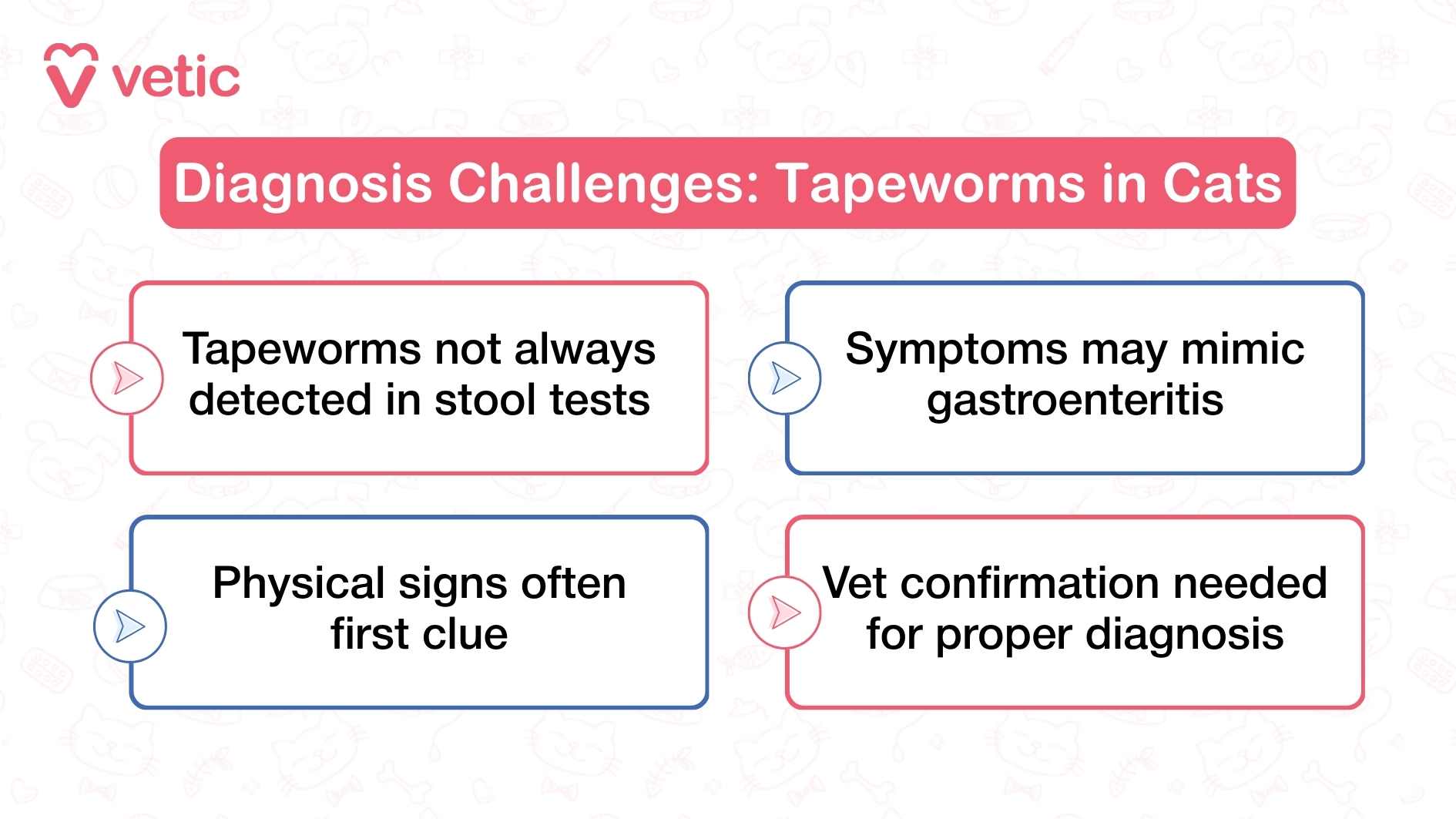
Tapeworms use hook-like mouths to attach to the intestinal wall and absorb nutrients from your cat’s food. Over time, this can cause:
- Nutritional deficiencies
- Digestive issues such as diarrhoea or vomiting
- In severe cases, intestinal obstruction
A heavy infestation of tapeworms may also lead to bloody diarrhoea, vomiting, and weight loss in cats.
Types of Tapeworms in Cats
While Dipylidium caninum is most common, cats can also get infected with other groups of tapeworms, including:
- Taenia species
- Echinococcus species
Each of these groups has species that can infect both cats and dogs, making regular deworming essential.
Signs of Tapeworm Infection in Cats
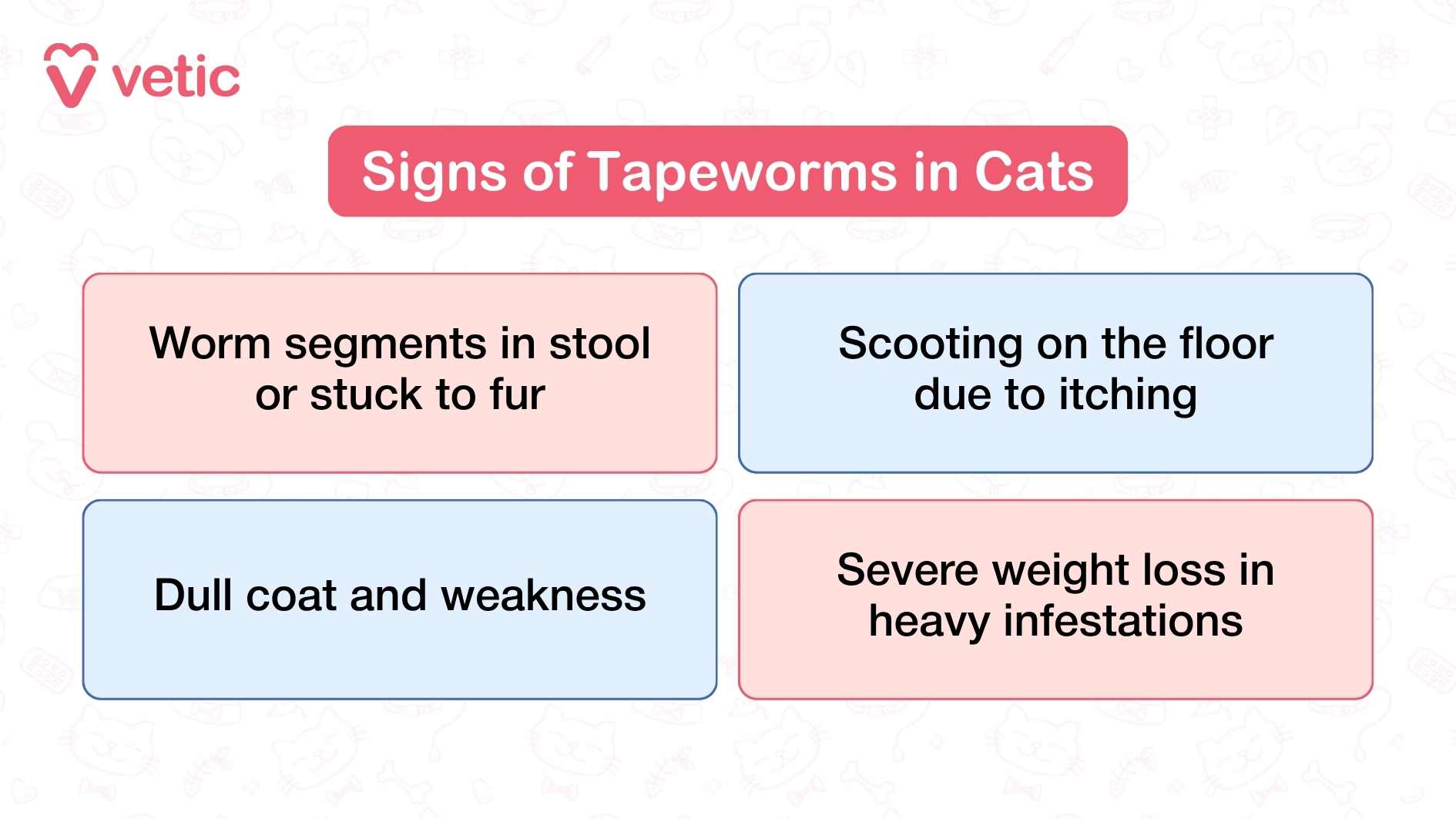
Tapeworms are one of the few intestinal parasites visible to the naked eye. Key signs include:
- Worm segments in the cat’s stool (1/8 to 1/4 inch long)
- Worm segments stuck to fur near the anus
Scooting or dragging their bottom due to itchiness - Dull coat and poor body condition
- Severe infestations leading to weight loss, malnutrition, and weakness
However, many cats don’t show symptoms until the infestation becomes heavy.
How Do Cats Get Tapeworms?
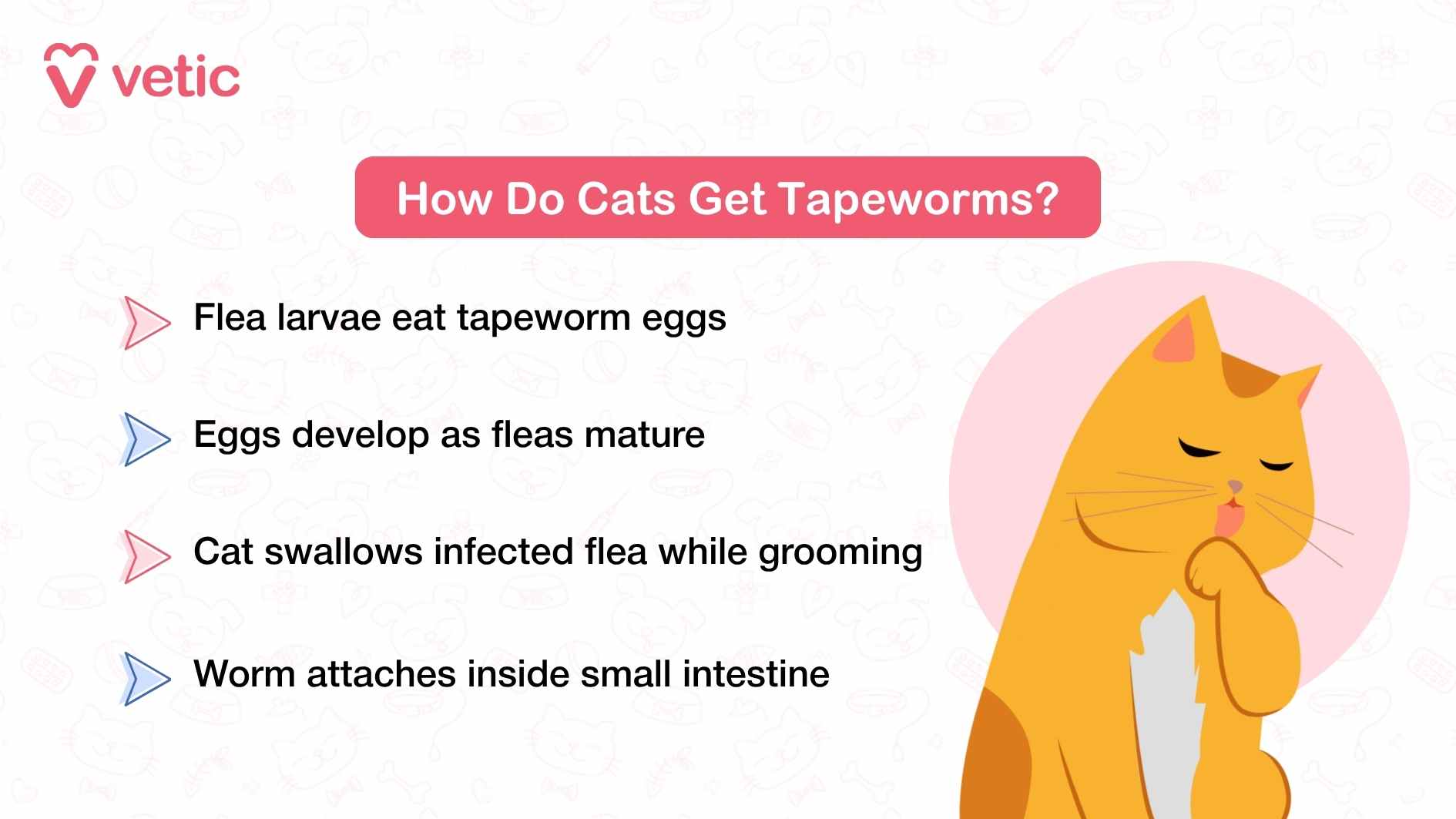
The lifecycle of a cat tapeworm almost always involves fleas:
- Flea larvae ingest tapeworm eggs.
- These eggs develop as the flea matures.
- A cat ingests the flea while grooming.
- The flea is digested, releasing the tapeworm egg.
- The egg hatches, and the adult tapeworm attaches to the cat’s intestine.
- Worm segments containing eggs pass out in stool, continuing the cycle.
Cats that spend time outdoors, hunt rodents, or live in flea-prone environments are at higher risk of tapeworm infection.
Diagnosing Tapeworms in Cats
Many pet parents identify tapeworms at home when they notice worm segments in stool or fur. In some cases, cats may need a veterinary diagnosis if symptoms resemble gastroenteritis or other digestive issues.
Conventional stool tests often miss tapeworms, so visual identification and veterinary consultation remain important.
Treatment for Tapeworm in Cats
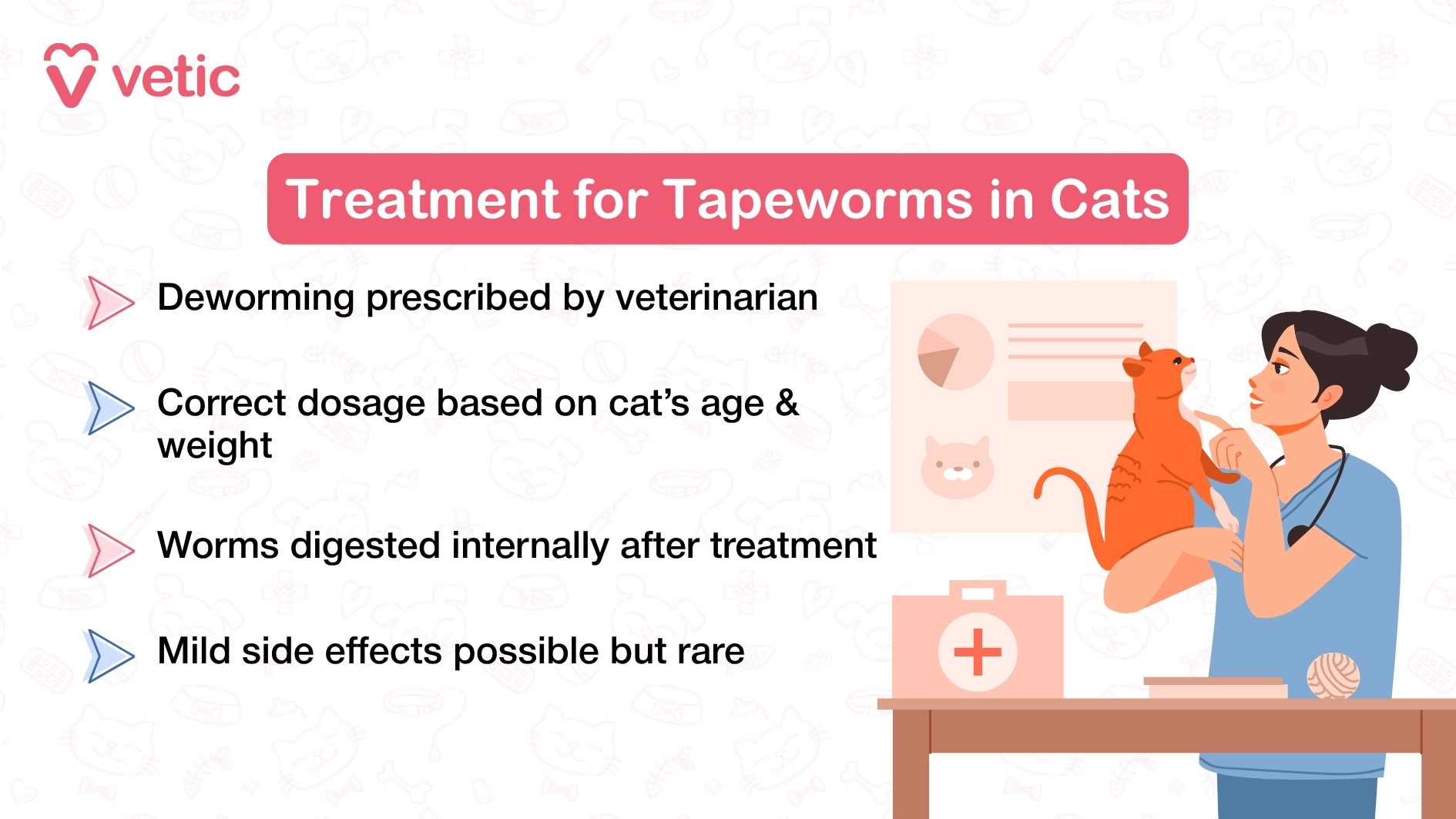
The standard treatment for tapeworm infection in cats is deworming medication. The right medicine and dosage depend on your cat’s age, weight, and health condition.
- Dewormers effectively kill adult tapeworms.
- Your vet may prescribe additional medication if multiple worm species are present.
- After treatment, tapeworms are usually digested internally, so you may not see them in stool.
Side effects of deworming are rare but may include mild vomiting, diarrhoea, or reduced appetite. If these persist for more than 12 hours, contact your veterinarian.
Prognosis of Tapeworm Treatment
When combined with flea control measures, treatment for tapeworms in cats generally has a good prognosis. Regular deworming and flea management can prevent reinfection.
Prevention of Tapeworms in Cats
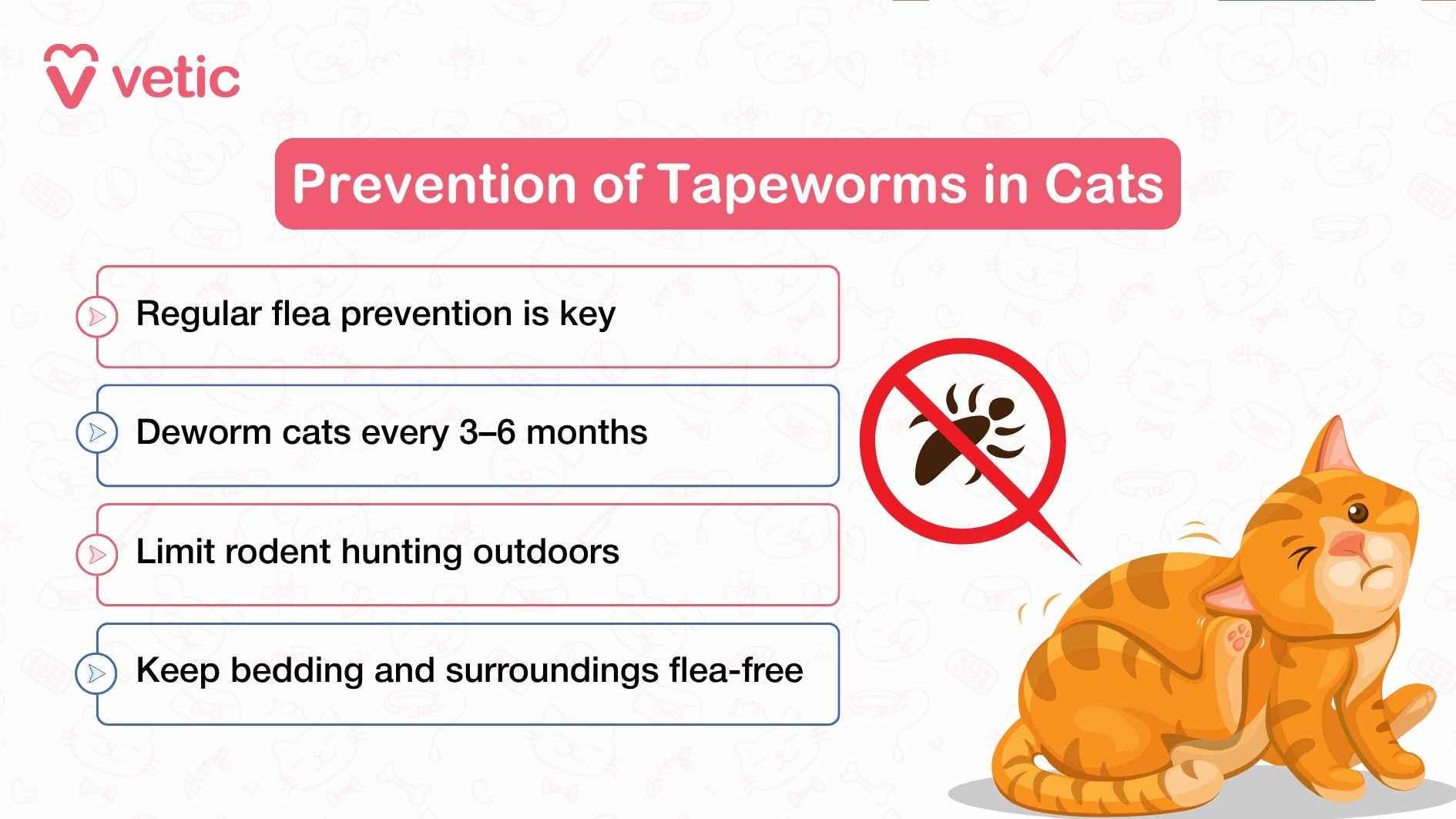
Prevention focuses on controlling fleas and rodents, the main carriers of tapeworm eggs. Here’s how to protect your cat:
- Use cat-safe flea prevention regularly.
- Keep your home clean with flea-control sprays or powders.
- Limit hunting behaviour in outdoor cats.
- Schedule periodic deworming as recommended by your vet.
Without flea control, reinfection can occur within 4–6 weeks.
Can Humans Get Tapeworms from Cats?
Although rare, humans can get infected with Dipylidium caninum if they accidentally swallow an infected flea. Some species, like Echinococcus, can also cause serious illness in people.
This makes routine cat deworming and flea control not only important for your pet, but also for your family’s safety.
FAQs About Tapeworm in Cats
Q1. Can indoor cats get tapeworms?
Yes. Even indoor cats can get tapeworms if fleas enter the home or if they accidentally ingest infected rodents.
Q2. What are the symptoms of tapeworm infection in cats?
Signs include visible worm segments in stool, scooting, dull coat, vomiting, diarrhoea, weight loss, and general weakness.
Q3. How do cats get tapeworm infections?
Most cats get tapeworms by swallowing fleas during grooming. Outdoor cats may also become infected by eating rodents carrying tapeworm larvae.
Q4. What is the treatment for tapeworm in cats?
Veterinarian-prescribed deworming medication is the safest and most effective treatment. The dosage depends on your cat’s age, weight, and health condition.
Q5. How often should I deworm my cat to prevent tapeworms?
Most vets recommend deworming every 3–6 months, depending on lifestyle, flea exposure, and outdoor activity.
Q6. Can tapeworms in cats spread to humans?
Yes, but rarely. Humans may get infected if they accidentally ingest fleas. Proper flea prevention and regular deworming reduce the risk.
Q7. Why does my cat still have tapeworms after deworming?
Reinfection is possible if fleas or rodents are not controlled. Along with deworming, consistent flea prevention is essential.
References:
Morelli, S., & co-authors. (2021). Canine and feline parasitology: Analogies, differences [Review]. Frontiers in Veterinary Science / PMC. https://www.ncbi.nlm.nih.gov/pmc/articles/PMC8404700/ PMC
Sweet, S., Szlosek, D., McCrann, D., Coyne, M., Kincaid, D., & Hegarty, E. (2020). Retrospective analysis of feline intestinal parasites: trends in testing positivity by age, U.S. geographical region and reason for veterinary visit. Parasites & Vectors, 13, Article 473. https://parasitesandvectors.biomedcentral.com/articles/10.1186/s13071-020-04319-4 BioMed Central+1
Beugnet, F., & others. (2018). Analysis of Dipylidium caninum tapeworms from dogs and cats. PMC. https://www.ncbi.nlm.nih.gov/pmc/articles/PMC6013090/ PMC
Adolph, C. B. (2021). Tapeworms (Cestoda) in dogs and cats. In Veterinary Parasitology (ScienceDirect). https://www.sciencedirect.com/science/article/abs/pii/B9780323509343001154 ScienceDirect
Evason, M. D. (2025). Updates on emerging and evolving gastrointestinal parasites of One Health importance. Veterinary Nursing Journal / MagOnLine. https://www.magonlinelibrary.com/doi/abs/10.12968/vetn.2025.0019b Maguire Online Library
Cornell Feline Health Center. (n.d.). Gastrointestinal parasites of cats. Cornell University. Retrieved from https://www.vet.cornell.edu/departments-centers-and-institutes/cornell-feline-health-center/health-information/feline-health-topics/gastrointestinal-parasites-cats Cornell Vet School
VCA Hospitals. (n.d.). Tapeworm infection in cats: What you should know. VCA. Retrieved from https://vcahospitals.com/know-your-pet/tapeworm-infection-in-cats Vca
TroCCAP. (2017). Guidelines for the diagnosis, treatment and control of feline endoparasites (Version 2). https://www.troccap.com/2017press/wp-content/uploads/2019/06/TroCCAP_Feline_Endo_Guidelines_English_Ver2.pdf

